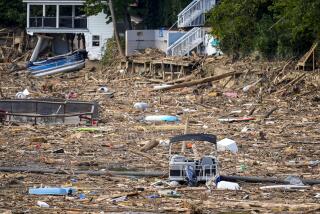Parish Saw Its Share of Nature’s Wrath
- Share via
CAMERON, La. — Carla Castillo, 11, was not supposed to be in Cameron on Tuesday, stepping over downed power lines and tadpoles, picking her way through the landscape left by the wave.
Two pairs of flip-flops were hanging on the branches of an old tree, along with a bag of Styrofoam cups. An air-conditioning vent from the Cameron Drug Store sat in the middle of Marshall Street. Seaweed hung from ceiling fan blades.
To the girl’s left was a gas station, or what had been a gas station before the hurricane peeled the metal siding off the pumps, leaving only the digital counters standing. Next to that was the Hibernia Bank. It had been washed away except for the roof and the vault -- a concrete box with a huge, shiny lock -- in one corner.
“Look, the bank! The bank is broken,” Carla said.
Behind Carla stood her mother and grandmother, motionless in a field of briny water, staring at the end of a piece of bright yellow tubing. Before the storm, that yellow pipe had been attached to the house where Carla and her family lived. Her mother and grandmother could not stop looking at it.
“We used to live here, but no more house. Over there was our house. No more house,” said Carla, whose family emigrated with her father, a shrimp fisherman, from Mexico four years ago.
The Gulf of Mexico has encroached on Cameron Parish before. According to a history of the parish on its website, the first white people to settle here were a family by the name of Phillips. They lived in a shack built of poles in the company of an Indian who had “attached himself to their household.” The Indian crossed the marshes after an enormous hurricane -- probably in 1824 -- to report to the nearest neighboring whites that the Phillipses were dead.
In 1957, Hurricane Audrey inundated Cameron at 4 a.m. with a roaring tidal surge, surprising many residents who had planned to evacuate the next day. Audrey killed 425 people, many of them children; townspeople took shelter on the second floor of the steel and concrete courthouse. It was the only building that survived the storm.
Forty-eight years later, residents of this parish still take June 27 as a holiday to commemorate Audrey. This summer, they met to discuss the establishment of a Hurricane Audrey Museum.
Sheriff Theos Duhon, 60, stood on the second floor of the same courthouse Tuesday, looking down at a flight of stairs, an unlighted cigar clenched between his teeth. Two-thirds of the way up the stairs was a muddy watermark, and that was the only point of differentiation he could offer. The water from Audrey had reached the top stair.
No one in Cameron died in Hurricane Rita, which battered the community with eight hours of 120-mph winds and a 20-foot storm surge, Duhon said. But the town is wiped out -- upside down and backward, shredded and left in piles.
The eye of the storm came ashore in this parish at 4 a.m. Saturday. There’s nothing left of Holly Beach, affectionately known as “the Cajun Riviera,” except skeletal pilings that once supported houses. Tiny bits of colorful debris -- plastic, fabric, insulation -- decorate tree limbs in the bayou for miles, and lie in a long line beside the shore.
Cameron’s buildings are now piles of cinder block and 2-by-4s. The water dismantled interior walls and stacked couches, refrigerators and recliners in back corners. When Duhon arrived, he found a red pickup truck wrapped around a tree in front of the courthouse. There was also a sign that read, “No Parking.”
“I said, ‘Well, isn’t that ironic,’ ” Duhon said.
Soldiers from the Louisiana National Guard’s 528th Engineering Battalion were bulldozing debris into sopping piles. Duhon was getting calls from evacuees desperate to return, but residents were not yet allowed back.
He tried to tell them there was nothing for them to come back to.
One family, he said, was insistent. “They said, ‘We can take it.’ I said, ‘It’s a slab only,’ ” he recalled, shrugging. “They wanted to know. I guess they’re going to have to come in and see it, to get closure, whatever you call it.”
For the Castillo family, closure was not easy to come by. The family had weathered the storm in the family’s shrimp trawler, which tossed so badly that Carla thought it would capsize.
She was afraid for her brother, who is 11 months old, too little to swim. And she was afraid for herself, she said.
“I don’t want to die,” she said. “I want to live.”
On Tuesday, Carla’s father anchored the trawler outside of Cameron, and the family clambered over the wet field where they used to live. Carla acts as an interpreter for her mother and grandmother, who speak only Spanish.
She was sent down Marshall Street to find a sheriff’s deputy and ask whether they could venture inland to look for a family truck.
“Mr. Tommy Thompson! Mr. Tommy Thompson!” she yelled.
He looked at the girl, standing barefoot in the water, surrounded by the wreckage. Her T-shirt said, “Gorgeous.”
“Baby, it ain’t going to run,” he said gently, and shook his head sadly. “You don’t need to be in this old water, sweetie.”
*
Times researcher Lynn Marshall contributed to this report.
More to Read
Sign up for Essential California
The most important California stories and recommendations in your inbox every morning.
You may occasionally receive promotional content from the Los Angeles Times.













